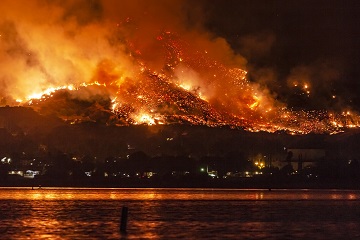Melting fire.jpg

A loss of sea ice, for example, appears to increase the risk of wildfires in the Pacific Northwest. Credit: slworking2, CC BY-NC-SA 2.0.
What happens in the Arctic doesn’t always stay in the Arctic. Changes in conditions in the Arctic Ocean can have an impact on land as well. A loss of sea ice, for example, appears to increase the risk of wildfires in the Pacific Northwest. Wildfires have been a growing problem in Washington, Oregon, and northern California for a couple of decades. Around Labor Day of 2020, for example, fires in Washington burned more than half a million acres in just 36 hours. And the 2021 fire season in California was the worst ever.
There are many reasons for the boost—many of them related to Earth’s changing climate. It’s bringing warmer and drier conditions to the northwest. And one cause may be less ice in the Arctic.
Researchers at the Pacific Northwest National Laboratory found that the amount of sea-ice has gone way down over the past 40 years. The scientists plugged those numbers into computer models of how the atmosphere responds to the change.
They found that, with less ice, the ocean surface and the surrounding land get warmer in late summer and early fall. That creates an updraft that pushes the polar jet stream away from its normal path. Low pressure builds off the coast of Alaska, with high pressure over Washington and surrounding areas. The combination brings warmer, drier air to the northwest over the last third of the year. That increases the risk that fires will ignite, and that they’ll burn longer—a big change thanks to changes in the Arctic Ocean.

